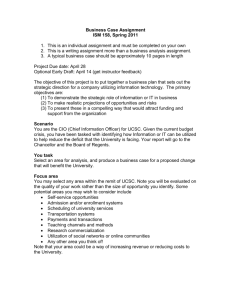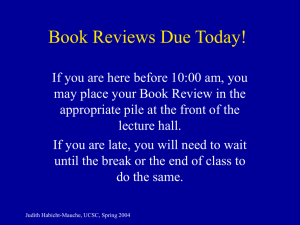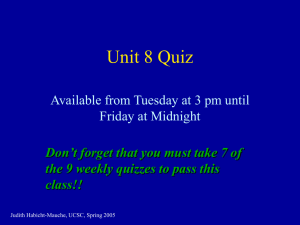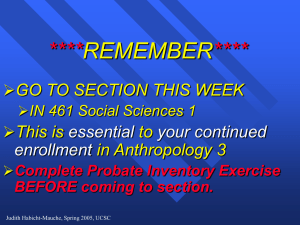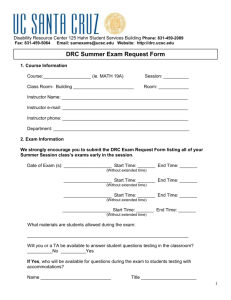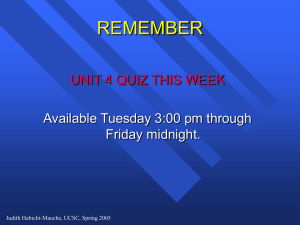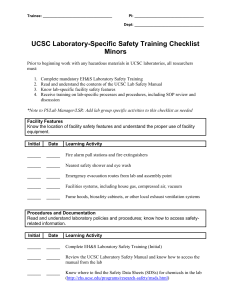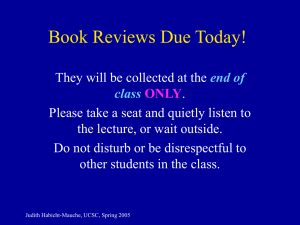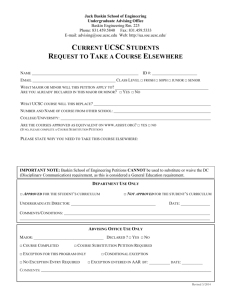Book Review Selection Forms Due in Section Week of April 12
advertisement
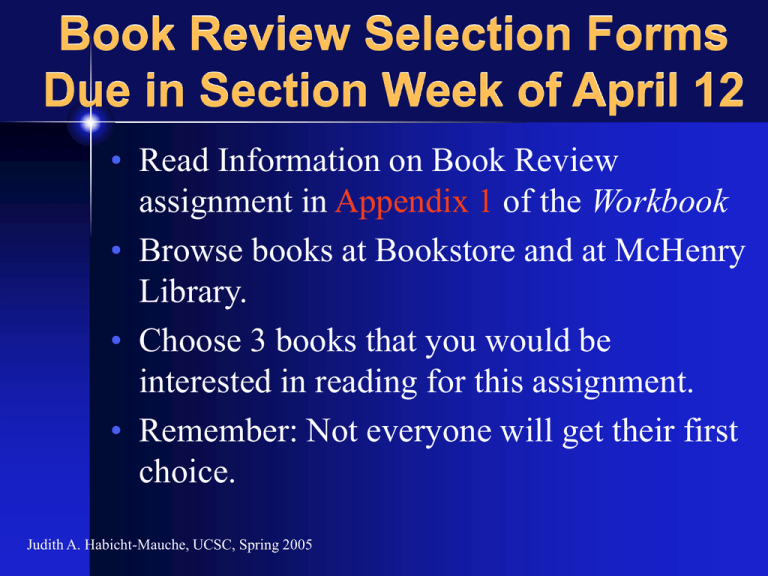
Book Review Selection Forms Due in Section Week of April 12 • Read Information on Book Review assignment in Appendix 1 of the Workbook • Browse books at Bookstore and at McHenry Library. • Choose 3 books that you would be interested in reading for this assignment. • Remember: Not everyone will get their first choice. Judith A. Habicht-Mauche, UCSC, Spring 2005 Realization of the Antiquity of the Human Species • Association of Stone Tools w/ Extinct Fauna • Discovery of pre-modern human fossils (Neanderthal, Germany) Thomas Huxley-- “The Missing Link” Whole of Human history can not be accounted for by Biblical time scale--The Idea of “Prehistory”. Stratigraphic section from Abbeville, France Judith A. Habicht-Mauche, UCSC, Spring 2005 Sommes Gravels, Near Abbeville France Excavated by Jacques Boucher des Perthes, French Customs Inspector “antediluvian axes...” Judith A. Habicht-Mauche, UCSC, Spring 2005 A Test of Human Antiquity: British Royal Society (1859) Creates Commission of Experts* Check B de P’s French evidence Dig a site with undisturbed stratigraphy *antiquarians & geologists, including Charles Lyell Judith A. Habicht-Mauche, UCSC, Spring 2005 Test of Human Antiquity at Abbeville 1859 • Boucher des Perthes’ claims verified stratigraphically by British Royal Society knives hatchets of flint Judith A. Habicht-Mauche, UCSC, Spring 2005 Brixham Cave, Windmill Hill, England Brixham Cave Chosen for excavation: stalagmite layer sealed underlying archaeological deposits Judith A. Habicht-Mauche, UCSC, Spring 2005 Brixham Cave Test: Relevant Evidence & Their Meanings • Stone artifacts = human handiwork • Fossil bones = extinct Ice Age species = Ice Age date • Stratigraphic order = time sequence • Association in 1 stratum = contemporary • A long span of human “pre-history” widely accepted by scholars Judith A. Habicht-Mauche, UCSC, Spring 2005 Unit 2, Lecture 1 North American Archaeology and the Native American Past Judith A. Habicht-Mauche, UCSC, Spring 2003 Myth of the Moundbuilders • Jefferson (1797) Notes on Virginia--first stratigraphic excavation in North America • Squier and Davis (1848) Ancient Monuments of the Mississippi • Cyrus Thomas (1894) 12th Annual Report of the Bureau of American Ethnography Judith A. Habicht-Mauche, UCSC, Spring 2005 Why a Mythical Race of Moundbuiders? • Lack of Historical Context--modern Indians not building mounds • Nationalist Motives--Americans seeking an ancient past in New World • Racist/Political Motives--Americans seeking justification for “Manifest Destiny.” Judith A. Habicht-Mauche, UCSC, Spring 2005 Impact of Moundbuilder Controversy on North American Archaeology • “Antiquities” of North America are associated with the ancestors of the modern Native Americans. • As such, have little relevance to National Heritage, largely defined in AngloAmerican terms • Archaeology in North America is part of Anthropology--the study of the “primitive” and the “other”. Judith A. Habicht-Mauche, UCSC, Spring 2005 Discovery of New World “Prehistory” • Native Americans only thought to be in New World for short time (Culture History) • 1927--Folsom, NM--stone spear point found in association with bones of extinct ice-age bison • America has truly ancient past comparable to Old World • New World laboratory for comparative study of major trends in social development and evolution (Processual Archaeology) Judith A. Habicht-Mauche, UCSC, Spring 2005 Native American Repatriation Movement • 1960s-70s--Increased Native American Activism • 1970s-80s--Public debates over treatment and deposition of Native American remains • 1990--Native American Graves Protection and Repatriation Act (NAGPRA) Judith A. Habicht-Mauche, UCSC, Spring 2005 NAGPRA • Protects Indian remains on federal and tribal lands • Recognizes tribal authority over treatment of human remains • Prohibits commercial selling of Indian remains • Requires institutions to inventory and repatriate human remains, associated grave goods, sacred objects and “objects of cultural patrimony” to tribal groups that can demonstrate “cultural affiliation” Judith A. Habicht-Mauche, UCSC, Spring 2005 Archaeology after NAGPRA • Native Americans placed on more equal footing with scientists, museums and universities in determining treatment of human remains and cultural artifacts • Ushered in new era of consultation, cooperation, negotiation between archaeologists and tribal groups • Made archaeologists more aware of the political context and consequences of their research (PostProcessual Critique) Judith A. Habicht-Mauche, UCSC, Spring 2005 And then there was Kennewick… • Scientists argued that Kennewick should not be repatriated under NAGPRA because: • May not be “Native American” • Too old to demonstrate “cultural affiliation” • Congress did not intend NAGPRA to apply to remains this old (9000 years) • Remains of significant scientific value to “the government”, i.e. ALL the people of the U.S. Judith A. Habicht-Mauche, UCSC, Spring 2005 August 2002 • Judge found in favor plaintiffs (scientists) • Remains did not fall under definition of Native American as defined by NAGPRA • Scientific study required to determine “cultural affiliation” • Protected by ARPA--of significant value to ALL Americans; part of our common National Heritage Judith A. Habicht-Mauche, UCSC, Spring 2005 The “Moundbuilders” Redux • The Kennewick Case: • Challenges a central premise of North American archaeology: that the ancient remains of this continent belong exclusively to the ancestors of the modern Native Americans Who owns America’s Past? Who should write its history? Whose voices and values should be given precedence in these debates? Judith A. Habicht-Mauche, UCSC, Spring 2005 Kennewick Man Debate • For Section Next Week: Be prepared to argue Kennewick Case from perspective of either The Plaintiff (Scientists) or The Defendants (Local NA, US Gov) • To prepare your “Brief” consult the following Web Sites: http://www.kennewick-man.com/ http://www.friendsofpast.org/ http://umatilla.nsn.us/ancient.html Judith A. Habicht-Mauche, UCSC, Spring 2005
